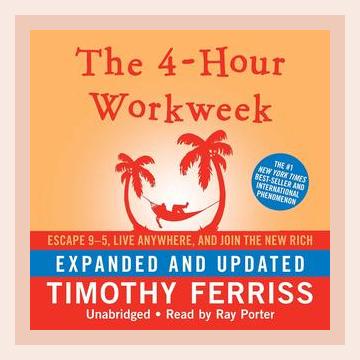Entrepreneurship and StartupsEntrepreneurial Mindset
**
Introduction
“The 4-Hour Workweek” by Tim Ferriss challenges conventional concepts of work and retirement. Ferriss introduces readers to the concept of the New Rich (NR), a group of people who have leveraged advancements in technology to live more freely and enjoy their lives now rather than waiting for retirement. The book is structured around the DEAL framework: Definition, Elimination, Automation, and Liberation.
Definition
Ferriss begins by redefining wealth. Money is not the true objective; rather, the ability to do what you want, when you want, and where you want is the ultimate goal. Life’s objective should be to achieve this personal freedom.
- Example: Ferriss shares his own experience of going from a stressed-out entrepreneur to someone who enjoys activities like Argentine tango and international travel. He emphasizes the idea of “mini-retirements” or frequent breaks from work throughout life rather than a long retirement at the end.
Action Step:
– Define your dreamlines: Write down what you want to have, be, and do in six months to one year. Determine the costs for achieving these dreams and break them down into monthly expenses.
Elimination
The elimination phase focuses on the concept of selective ignorance and the 80/20 Principle (Pareto’s Law) – 80% of results come from 20% of efforts. Ferriss advocates cutting out non-essential tasks which don’t contribute significantly to one’s goals.
- Example: Ferriss describes how he checked his email only twice per day and reduced his business operation hours by instructing his employees to handle more decisions independently. This drastically reduced his workload and stress.
Action Step:
– Implement a low-information diet: Avoid unproductive media and unnecessary information. Limit checking emails to specific times, such as once at noon and once at 4 PM.
Automation
Ferriss explains how to automate income through outsourcing and creating a muse – a low-maintenance business that generates a steady stream of revenue.
- Example: Ferriss started BrainQUICKEN, a nutritional supplements business, which he later automated by hiring virtual assistants from global platforms like Elance and using fulfillment services to handle orders.
Action Step:
– Outsource personal and business tasks using platforms like Upwork or Fiverr. Start by identifying repetitive tasks that consume your time and delegate them to VA (Virtual Assistants).
Liberation
Liberation is about creating time and mobility. Ferriss emphasizes the importance of getting out of the office to prove that physical presence and uninterrupted hours do not necessarily correlate with productivity.
- Example: He negotiated remote work with a proposal highlighting increased productivity if he was allowed to work from locations of his choice. This set a precedent for spending more time away from a traditional office setup.
Action Step:
– Arrange a remote trial with your employer. Suggest a two-week trial period to demonstrate that you can be more productive working remotely. Back your proposal with concrete data on tasks you will accomplish.
Example Strategies and Tactics
- Batching Tasks
- Ferriss discusses how grouping similar tasks together (batching) can significantly cut down the time needed to complete them.
Action Step:
– Combine repetitive tasks, like processing order returns or administrative duties, into single sessions to avoid switching costs.
- Mini-Retirements
- Instead of one long retirement, Ferriss advocates taking multiple mini-retirements throughout one’s life.
Action Step:
– Plan a mini-retirement by calculating the savings required and logistics needed to take a 1-3 month break to live in a different country or pursue a hobby.
- Creating a Muse
- Ferriss emphasizes the importance of creating a side business (muse) that requires minimal attention but provides sufficient income.
Action Step:
– Identify a niche market and develop a product (physical or digital) that you can automate using dropshipping services or digital courses.
- Fear-Setting
- Ferriss introduces “fear-setting” as a mental exercise to overcome obstacles. It involves imagining the worst-case scenario and planning mitigations for it.
Action Step:
– Write down your fears, define preventive steps to avoid those fears materializing, and outline a recovery plan if they do.
Tools and Resources
Ferriss provides numerous resources, including books, websites, and tools that can assist in implementing the 4-Hour Workweek philosophy.
- Example: He frequently mentions tools like Google AdWords for testing business ideas quickly and tools like Evernote for organizing tasks.
Action Step:
– Leverage tools that Ferriss recommends. For instance, use Google AdWords to test the viability of a new product idea by running a small-scale advertisement campaign.
Case Studies and Success Stories
The book features several case studies of individuals who successfully applied Ferriss’s principles, such as the story of an overworked ad executive who outsourced tasks and transitioned to working remotely while traveling the world.
- Example: The story of a couple who created a niche product, automated its sales process, and managed to live a nomadic lifestyle while running their business.
Action Step:
– Read through the case studies in the book and identify strategies used by others that could be personalized and adopted for your own goals and context.
Assessment and Reflection
Ferriss encourages continuous assessment and iteration of one’s approach. He advises readers to routinely reflect on the effectiveness of their current strategies and remain flexible in optimizing their work processes.
- Example: Ferriss himself regularly reevaluates his business processes and lifestyle choices to ensure they align with his evolving goals and preferences.
Action Step:
– Schedule periodic reviews (weekly or monthly) to assess what is working well and what needs adjustment. Implement changes based on your reflections to improve productivity and life satisfaction.
Conclusion
“The 4-Hour Workweek” offers a paradigm shift from traditional work models to a lifestyle oriented around personal freedom and effectiveness. Through practical steps and real-life examples, Ferriss guides readers to escape the conventional 9-5 grind, live anywhere, and join the New Rich. By defining your goals, eliminating inefficiencies, automating income, and liberating yourself professionally and geographically, you can achieve a more fulfilling and balanced life.
